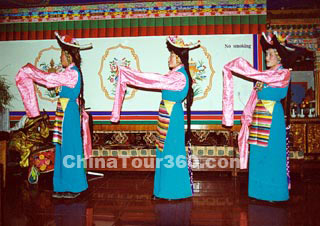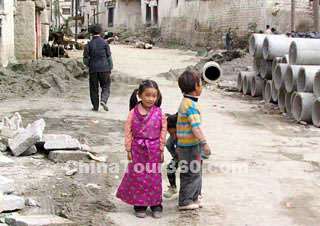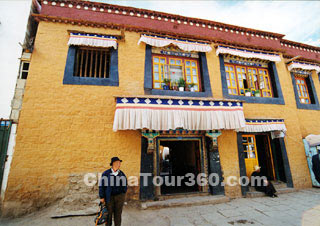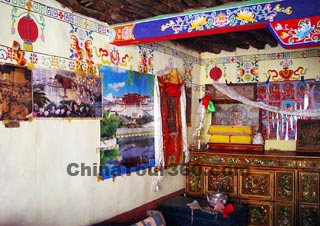The Tibetan population, at 5,416,021(in 2000), is mainly distributed in the Tibet Autonomous Region, Qinghai, Gansu, Sichuan and Yunnan provinces.
It is an old nationality in China. According to historical records, early before the Qin and Han dynasties, the ancestors of the Tibetans gathered along the banks of the middle reach of the Brahmaputra. Due to the vast grasslands and lush pastures, sheep, goat and yak were easily fed and stockbreeding gradually became their main economic support. They also engaged in agriculture and highland barley, a grain which is the material of zanba and ghee. Wheat, peas and canola are also planted.
|
|
Zanba, mutton and beef are the staple food of Tibetans. In some areas, rice and noodles are also a regular part of the diet. Tea with butter or milk, yoghourt and cheese are the favorites of all Tibetans.
With a long history, they have their own language and letters. The wide use of Tibetan language promotes the economic and cultural exchange between the Tibetan and Han people. They also have their own calendar, in which November 1st is their New Year.
The period from the 10th century to 16th century was the golden age of Tibetan culture. Tibetan art has a dual character: on the one hand, it seems related to Indian art, with its artistic patterns and stress on deep red, blue and green; on the other, it is distinctively Tibetan, different from both the East and the West.
Tibetan garments still keep with the original styles. Both men and women wear long-sleeved silk or cloth jackets topped with loose gowns tied with a band on the right. Men wear trousers and women wear skirts. All men and women wear woolen or leather boots. Both genders keep long hair and like to wear ornaments. Men usually wear a braid coiled on top of the head. Women, when coming of age, begin to plait their hair into two braids or many tiny ones adorned with ornaments.
|
|
Tibetans believe in Lamaism (a branch of Buddhism). Buddhism was introduced in the 13th century and from the 13th to 16th centuries Buddhism prevailed in Tibet. Buddhist temples were widely built throughout Tibet during this time. Of these temples Ganden Monastery, Drepung Monastery, Sara Monastery and the Potala Palace are the most famous.
Tibetans have many taboos that mould their daily life. Shrimp and fish, eggs, and the meat from dogs, donkeys, horses, and cats are forbidden in their diet. Cutting, fishing, hunting and nudity are forbidden near the temple. Inside men and women cannot sit together.
Most Tibetan festivals are religious. The Buddha-Unfolding Festival (Festival to Worship the Buddha statues) is held in the Tashihunpo Monastery in the fifth month of the Tibetan calendar. The festival lasts for three days, and different Buddha statues are exhibited for worship each day.
Other main Tibetan festivals include the Shoton Festival, Great Prayer Festival, Butter Lamp Festival, Saga Dawa Festival, Gyangtse Horse-Race Festival, Nakchu Horse-Race Festival and Yarlung Culture Festival.











